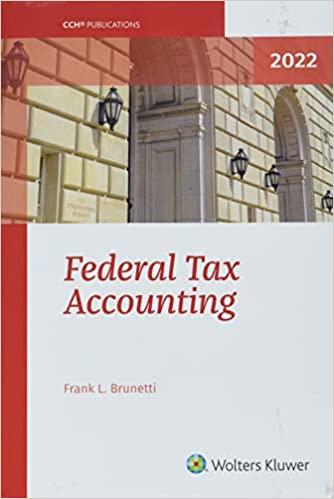

1. Reba divorced her husband several years back. In the current year (2019), she received $87,000 in salary, $25,000 in child support from her ex-husband, and $4,500 in interest income. Her three children, Cheyenne, Jake, and Kyra, lived with her this year but only Jake and Kyra qualify as her dependents and count as qualifying persons for determining filing status. In addition, she has $6,000 in total itemized deductions available for the year. Assume she is not subject to AMT, is not self-employed, does not qualify for any additional tax credits, and has not made any prepayments of tax for the year. a. What filing status should Reba use for her 2019 tax return? b. Regardless of your answer in a., assume that Reba used Single as her filing status in 2019. Use the information above, the appropriate Federal Tax Schedule and other values from Appendix D, and the individual tax formula to calculate Reba's 2019 tax due at the end of the year. c. Regardless of your answer in a., assume that Reba used Single as her filing status and had $10,000 of itemized deductions available instead of $6,000. Would this change Reba's taxes due at the end of the year? What is the tax due in this updated scenario? d. Regardless of your answer in a., assume that Reba used Single as her filing status and had $20,000 of itemized deductions available instead of $6,000. Would this change Reba's taxes due at the end of the year? What is the tax due in this updated scenario? 2019 Tax Rate Schedules Individuals Schedule X-Single Schedule Z-Head of Household If taxable income is over: But not over: If taxable income is over: But not over: The tax is: The tax is: $ $ 0 9,700 $ 9,700 $ 39,475 $ 0 $ 13,850 $ 13,850 $ 52,850 $ 39,475 $ 84,200 $ 52,850 $ 84,200 $ 84,200 $160,725 $ 84,200 $160,700 10% of taxable income $970 plus 12% of the excess over $9,700 $4,543 plus 22% of the excess over $39,475 $14,382.50 plus 24% of the excess over $84,200 $32,748.50 plus 32% of the excess over $160,725 $46,628.50 plus 35% of the excess over $204,100 $153,798.50 plus 37% of the excess over $510,300 10% of taxable income $1,385 plus 12% of the excess over $13,850 $6,065 plus 22% of the excess over $52,850 $12,962 plus 24% of the excess over $84,200 $31,322 plus 32% of the excess over $160,700 $45,210 plus 35% of the excess over $204,100 $152,380 plus 37% of the excess over $510,300 $160,725 $204,100 $160,700 $204,100 $204,100 $510,300 $204,100 $510,300 $510,300 - $510,300 Schedule Y-1-Married Filing Jointly or Qualifying Widow(er) Schedule Y-2-Married Filing Separately If taxable income is over: If taxable income is over: But not over: The tax is: But not over: The tax is: $ $ 0 9,700 $ 9,700 $ 39,475 $ 0 $ 19,400 $ 19,400 $ 78,950 $ 39,475 $ 84,200 $ 78,950 $168,400 $ 84,200 $160,725 $168,400 $321,450 10% of taxable income $1,940 plus 12% of the excess over $19,400 $9,086 plus 22% of the excess over $78,950 $28,765 plus 24% of the excess over $168,400 $65,497 plus 32% of the excess over $321,450 $93,257 plus 35% of the excess over $408,200 $164,709.50 plus 37% of the excess over $612,350 10% of taxable income $970 plus 12% of the excess over $9,700 $4,543 plus 22% of the excess over $39,475 $14,382.50 plus 24% of the excess over $84,200 $32,748.50 plus 32% of the excess over $160,725 $46,628.50 plus 35% of the excess over $204,100 $82,354.75 plus 37% of the excess over $306,175 $160,725 $204,100 $321,450 $408,200 $204,100 $306,175 $408,200 $612,350 $306,175 $612,350








